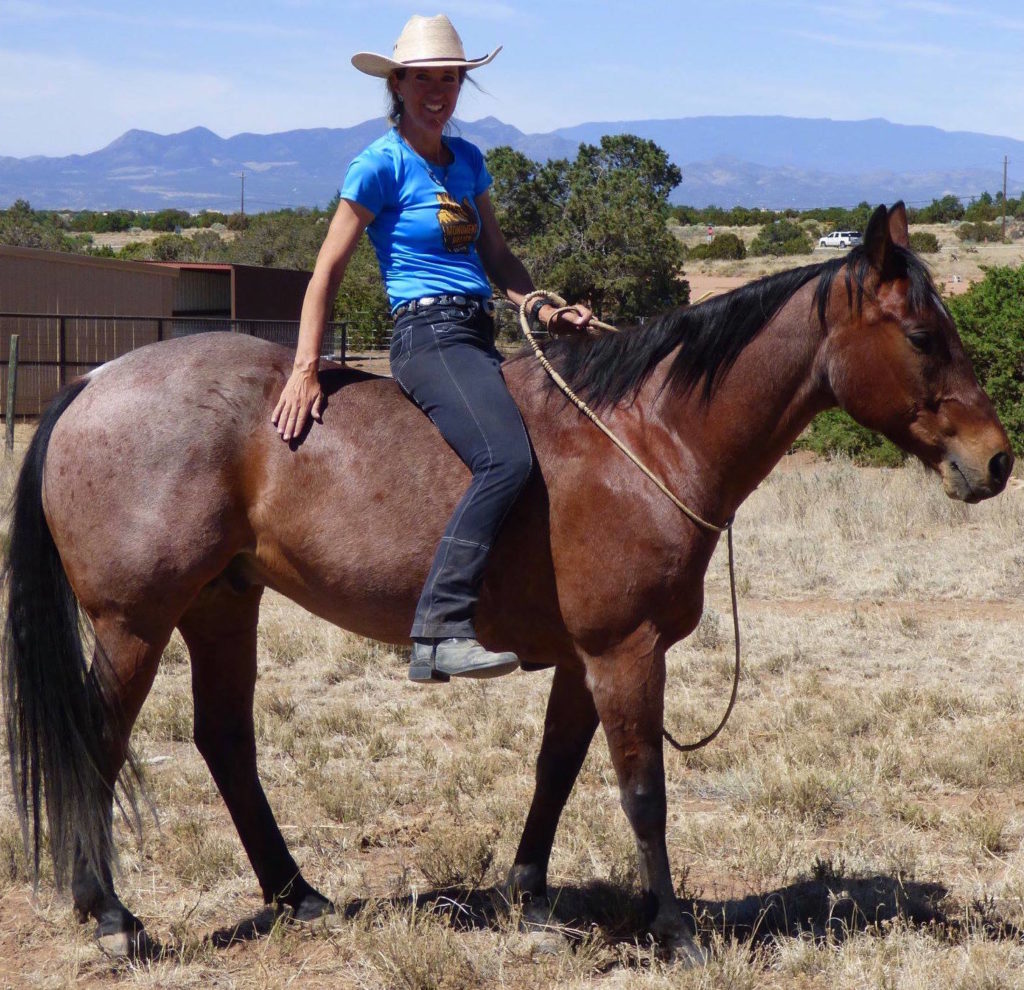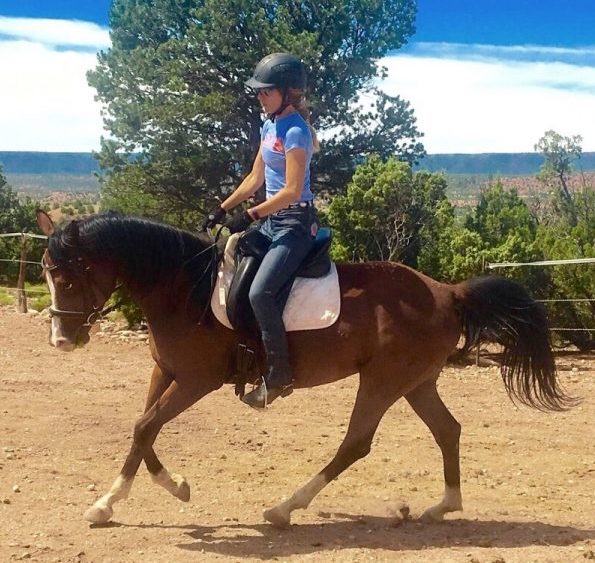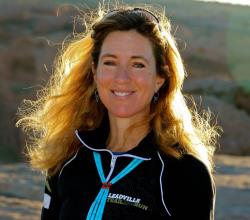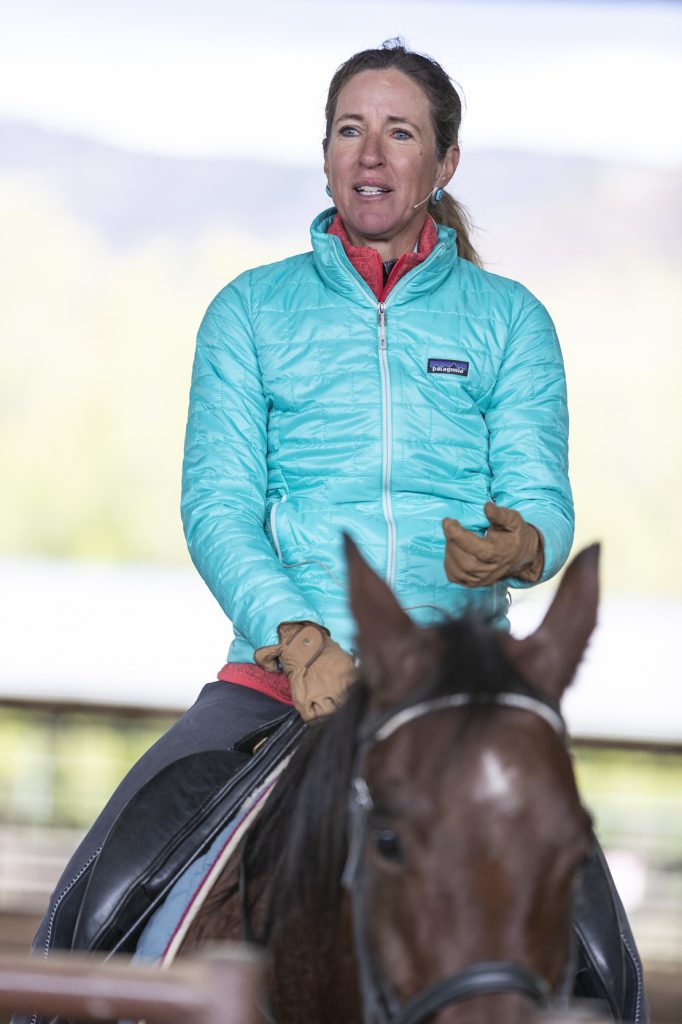 Editor’s Note: Best Horse Practices Summit presenter Katrin Silva grew up riding dressage in Germany before moving to the United States at age 19 to learn to ride Western. She’s been riding both disciplines for the last twenty years and is a regular guest columnist for Cayuse Communications. She lives in New Mexico where she works with dressage and Western clients. Visit her blog here.
Editor’s Note: Best Horse Practices Summit presenter Katrin Silva grew up riding dressage in Germany before moving to the United States at age 19 to learn to ride Western. She’s been riding both disciplines for the last twenty years and is a regular guest columnist for Cayuse Communications. She lives in New Mexico where she works with dressage and Western clients. Visit her blog here.
Buy her book, Dressage for All of Us here.
Read Diagnosis Offers Eureka Moment
Read Our Bodies Can Limit Our Horses’ Movements
Silva writes:
I recently watched a video of myself riding a young horse. The horse looked good – rhythmic, forward, and under control most of the time. I, on the other hand, looked terrible. My hands bounced up and down. My shoulders seemed stuck somewhere in the vicinity of my ears, the right one higher up than the left. My lower legs looked like they had a hard time deciding where they wanted to be – too far forward, or too far back. My entire body looked tense. If I had been a horse, I would not have wanted to ride myself.

Katrin Silva
I reacted with understandable horror. I know that a crooked, stiff rider creates a crooked, stiff horse. Horses reflect the way we sit on them. If my back does not follow the horse’s back, the horse’s back will stop swinging. If my hands are not able to keep an elastic connection with the horse’s mouth, correct contact will never develop. Horses go the way we ride them, which is why a rider’s seat is so important.
I called one of my mentors, in this case Ulla Hudson, a wise and kind teacher who has known me for over a quarter century. She listened to me whine for 15 minutes, then promised to come and take a look at the dire situation I described.
Her assessment was swift and surprising: “I can’t help you. You don’t need me standing here telling you over and over to keep your hands quiet. You need to get some body work.”
I stared at Ulla. This had never occurred to me before. Body work? Me? Why?
I am almost 50 years old. I have had two massages in my entire life, both gifts from my husband, who gets massages on a regular basis and claims they keep him from moving like a geriatric zombie. I’ve always considered massage an extravagance. What’s next, a manicure?
 I ride several horses a day, six days a week, and run ultramarathons as a hobby, so there’s little time for things like stretching, foam rolling, or self-indulgent spa days, which is what body work sounded like to me.
I ride several horses a day, six days a week, and run ultramarathons as a hobby, so there’s little time for things like stretching, foam rolling, or self-indulgent spa days, which is what body work sounded like to me.
And yet over the last 30 years, I’ve been bucked off, knocked down, stepped on, and dragged. I’ve suffered bruises, cracked ribs, black eyes, and broken toes, but never anything serious. Like my riding injuries, by running injuries have healed pretty much by themselves. So why would I need body work?
I generally do what Ulla tells me to do, so, in spite of my doubts, I scheduled an appointment with Randy Nakasone, a physical therapist and body worker with an excellent reputation. I’ve sent students to him and seen the difference his work can make in how they ride. I just never thought of going to see him myself.
Here I was, being prodded, pushed, and pulled on. He proclaimed me a total mess: “Your left hip is lower than your right. Your pelvis is out of whack. These vertebrae are out of alignment . . . the list went on.
When he was done, I felt better. The niggling pain in my left hip I’d been ignoring for . . .months? years? was now much more manageable, as was the tightness in my lower back. I walked out of his office with greater ease than I had walked in with. I even promised to come back for more.
The real revelation was the improvement in my riding the next day. My hips and lower back were able to follow the horse’s back, which in turn quieted my hands and legs.
It’s been a major light bulb moment. I am now a body work convert.
We take the best possible care of the horses we work with. We make sure they balance hard work with rest. We schedule appointments with farriers and chiropractors. We know that warming up and cooling down are important parts of our horse’s workout. We feed them high-quality hay and monitor their weight and energy level. Why do we do all this? Because we owe it to them. Because we ask them to carry us for hours at a time. Because they can’t move their bodies in unison with ours when they’re in pain, when their muscles are stiff or underdeveloped, when their spine is out of alignment, or when discomfort interferes with their mental processes.
 My resolution for 2020 is to treat myself more like I treat my horses. I will make time for body work, massages, warm-ups, cool-downs, stretching, and adequate rest. I want to keep riding for the next thirty years. And I want to do it in a way that won’t hurt my horses.
My resolution for 2020 is to treat myself more like I treat my horses. I will make time for body work, massages, warm-ups, cool-downs, stretching, and adequate rest. I want to keep riding for the next thirty years. And I want to do it in a way that won’t hurt my horses.
Taking care of our bodies is an important part of riding well. Riding well is an important part of taking care of our horses. It might be embarrassing to admit that it took 30 years to figure this out, but better late than never.
Body work for the horse also is important, because how you sit/ride affects the horse.
A combination of different types of body will significantly improve your riding. I recently had a massage by an awesome massage therapist. She did some wonderful scapula area releases, hip rebalancing & general muscle releases. The next day my connect to my horses through the
back & scapulas had greatly improved & my seat was much improved. The Alexander Technique, esp., Sally Swift approach will create a soft, supple & quiet rider.